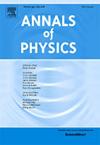重访引力原子:精确标量云解
IF 3
3区 物理与天体物理
Q2 PHYSICS, MULTIDISCIPLINARY
引用次数: 0
摘要
在这项工作中,我们研究了Dyonic Kerr-Sen黑洞(DKSBH)时空中Klein-Gordon方程的完美束缚态,即众所周知的中性标量云。由于该系统与氢原子中的质子-电子结构非常相似,因此带有玻色子云的黑洞被称为引力原子。DKSBH本身是Einstein-Maxwell-Dilaton-Axion理论中最一般的3+1维黑洞解,它推广了所有Kerr族解,包括Kerr、Kerr- newmann、Kerr- emda及其各自的dilatonic版本。传统上,标量云的研究是通过被称为AAM技术的近似技术进行的,该技术适用于超轻标量场和低黑洞自旋状态。在这项工作中,我们的目标是通过首先发现和研究黑洞时空中大质量Klein-Gordon方程的精确解,重新审视黑洞标量云的理论。我们发现标量云的精确解是用Confluent Heun函数表示的,它的精确谱符合径向解的多项式条件。利用精确解,我们可以在不受超轻标量质量或慢速黑洞限制的困扰下研究标量云。最后,我们发现黑洞标量云的精确特征频率同时考虑了黑洞事件视界和柯西视界的影响。本文章由计算机程序翻译,如有差异,请以英文原文为准。
Revisiting the gravitational atom: Exact scalar cloud solution
In this work, we investigate perfectly bound states of the Klein–Gordon equation, well-known as the neutral scalar cloud, in the Dyonic Kerr-Sen black hole (DKSBH) spacetime. Because the system closely mimics the proton-electron structure in a hydrogen atom, the black hole bearing a boson cloud is referred as a gravitational atom. DKSBH itself is the most general 3+1 dimensional black hole solution of the Einstein–Maxwell-Dilaton–Axion theory, generalizes all Kerr-family solutions, including Kerr, Kerr–Newmann, Kerr-EMDA, and their respective dilatonic versions. Conventionally, the scalar cloud is investigated via approximation technique known as the AAM technique, which works in ultralight scalar field and low black hole’s spin regime. In this work, we aim to revisit the theory of the black hole’s scalar cloud, by firstly finding and investigating the exact solution to the massive Klein–Gordon equation in the black hole spacetime. We find that the scalar cloud exact solution is obtained in terms of the Confluent Heun function and its exact spectrum corresponds to the polynomial condition of the radial solution. Working with exact solution, we can examine the scalar cloud without being troubled by ultralight scalar mass or the slow black hole limit. Finally, we discover that the exact characteristic frequency of the black hole’s scalar cloud takes into account the effect comes from both the black hole’s event horizon and the Cauchy horizon.
求助全文
通过发布文献求助,成功后即可免费获取论文全文。
去求助
来源期刊

Annals of Physics
物理-物理:综合
CiteScore
5.30
自引率
3.30%
发文量
211
审稿时长
47 days
期刊介绍:
Annals of Physics presents original work in all areas of basic theoretic physics research. Ideas are developed and fully explored, and thorough treatment is given to first principles and ultimate applications. Annals of Physics emphasizes clarity and intelligibility in the articles it publishes, thus making them as accessible as possible. Readers familiar with recent developments in the field are provided with sufficient detail and background to follow the arguments and understand their significance.
The Editors of the journal cover all fields of theoretical physics. Articles published in the journal are typically longer than 20 pages.
 求助内容:
求助内容: 应助结果提醒方式:
应助结果提醒方式:


